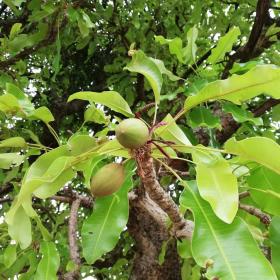The shea tree (Butyrospermum Parkii; also called Free of Life or Butter Tree) grows only in the African savannah region, in a well-defined zone from Guinea in the west to Central Africa in the east; you can see the trees: 10 – 20 m in height, with very dark leaves reminding of those of an oak tree. The shea tree grows only wild and cannot be cultivated. Fruits falling to the ground or animals eating the fruit pulp and getting rid of the seed, make sure that new trees grow to replace the old ones. The tree is very resistant to fires, which are so common during droughts, and it is not unusual for a tree to reach the age of 200 years. The tree is most productive when between 50 and 100 years old.
The fruits change from green to yellow-brownish when maturing from May to August. As the fruits fall from the trees, African women collect the nuts. The shea fruit has a high water content and should thus be gathered as soon as possible—or it may start to germinate or be destroyed by worms and insects. Also, the FFA content may rise quickly, and the oil content may be reduced. The ripe nut has a fat content of 45 – 50 percent and a water content of 45 percent.
The process of extracting the oil starts as soon as the harvest is over - it usually lasts for some five months. Despite the African heat, the women gather to work the kernels with big mortars, pounding the pulp with great effort in time to create a lively and rhythmic song. After that, water is added, and the pulp is left to boil. Eventually, the oil is separated from the water, and the valuable oil is cared for. The oil is mainly used for cooking, as a face cream, and for fuel and soap production. The remains of the pounded nuts, i.e., the doughy material left after the boiling, are used to reinforce the local clay huts against rain and heat.
A relatively small part of the total shea nut production is exported in nuts or oil. Trading wild-growing raw materials is much more complicated than dealing with traditional agricultural products—the raw materials are more expensive, and the supply is much less secure and stable. A producer of specialty fats must thus tie up substantial amounts of capital in reserve stocks to access the necessary volumes, even in periods with insufficient supply on the market.